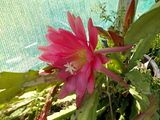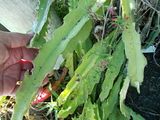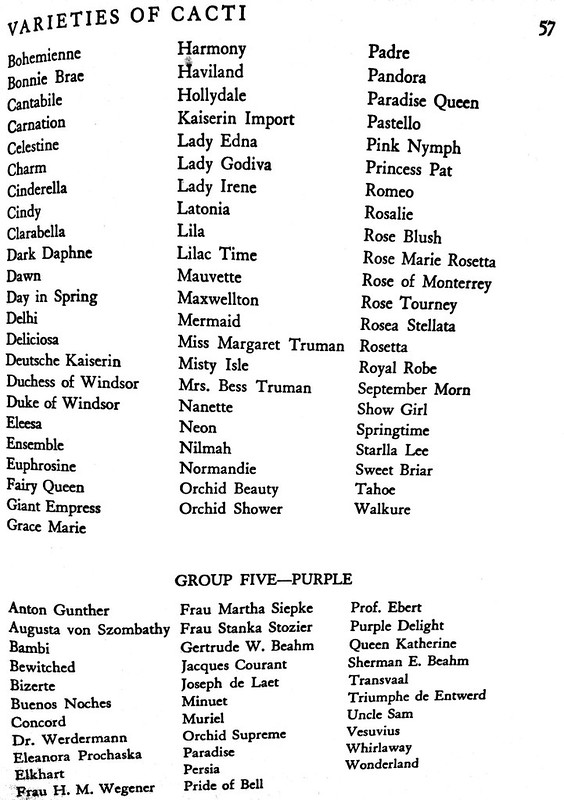|
|
Post by cortona on Apr 27, 2014 7:40:19 GMT -5
longhhorn, i continue to collect cactus wile i grow my food, and the breeding passion start with cactus for me!
|
|
|
|
Post by Al on Jan 4, 2015 12:11:52 GMT -5
Growing & collecting cacti & succulents was an all consuming passion for me from about the age of 14. About 500 of them were crammed into a greenhouse & every window of our London townhouse, the window cleaner must have hated me! Not at all sure why I didn't just play football like all the other boys, must be some kind of fascination with their architectural forms, or just undiagnosed extreme male brain autism. After I left home my mother quickly managed to kill them all & I realised the futility of trying to grow such tender plants so far north, I now have a small number of toughies. One Opuntia amazingly collected from a Swiss hillside, a very dry south facing slope in the Valais region, it is happy in the greenhouse through very cold Scottish winters. It even fruits but the little red prickly pears are not great, except that they must be among the most northerly cactus fruit grown without heat.
|
|
|
|
Post by Walk on Jan 5, 2015 9:48:05 GMT -5
FYI, There is an opuntia variety that is native to the upper midwest of the USA. I've seen large patches of it in SW Wisconsin where winters can easily go to -25*F or colder. They're amazing to see in flower.
I too once had a cacti and succulent collection (only about 100 kinds) and was fascinated by their diversity. I still have a few. One is a mammilaria type that my grand uncle gave me over 50 years ago. He called it his fire cracker cactus because it gets little red cylindrical fruits all over it (about 1/8" diameter by 1/2" long). I also have a twisted hearts or rosary plant which is a South African succulent. It was my mother's and her start came from an aunt. I remember that my aunt's plant was in the kitchen and the vines were wound round and round the crown molding in her kitchen - not sure how many "laps" they grew over the years or if she ever trimmed them as I do. I've kept these 2 plants going because of the family connection and they are each conversation starters.
|
|
|
|
Post by greenfinger on Jan 31, 2015 18:14:27 GMT -5
I brought a cactus home from the wild, after enjoying the fruit. It's been three years and no fruit since. The fruit was only the size of my thumb though. Any one know the name of a variety that is near the size of Rowan's fruit and tasty? And maybe spineless fruit?
|
|
|
|
Post by rowan on Jan 31, 2015 18:49:11 GMT -5
Someone who seen my post on this fruit on my blog asked for a piece to grow and send off to be analysed to find out exactly what it is. When he got the cutting he said it is a South American epiphyllum that should not be able to grow here, let alone fruit.
He hasn't got back to me yet with any more info but there is more fruit on the original plant (my plants from cuttings didn't flower this year but they were abused a bit, lol) so I will send him a fruit when they ripen, if I get over there to pick them at the right time).
|
|
|
|
Post by rowan on May 26, 2015 19:13:26 GMT -5
Update.
Samples of this plant and fruit were sent to a botanical garden and university to identify but they were unable to positively identify it. Apparently it could be an unknown hybrid that should not be able to grow down here, especially outside during my winter, so it has many people excited. People here who can't grow dragon fruit will now have an alternative.
An Australian rare fruit tree nursery (Daleys fruit) is going to propagate it and sell it under the name 'Rowans Red' so members from Australia can keep an eye out for it. I am pretty pleased to be able to get this fruit out in the market.
|
|
|
|
Post by templeton on May 27, 2015 19:41:46 GMT -5
Great news, Rowan.
I do intend to come and visit sometime and pick one up. June or July sometime?
T
|
|
|
|
Post by rowan on May 27, 2015 21:15:33 GMT -5
You can come and visit anytime but give me a weeks notice as winter is my off time and I am often away visiting.
|
|
|
|
Post by steev on May 28, 2015 2:40:18 GMT -5
Cactus fruit is very interesting; there is a Pitahaya in Guatemala (large, lobed, purple flesh which is insipid), largely sold to tourists; there is also a smaller, un-lobed, goose-egg-sized, white-fleshed one that is excellent, tangy and flavorful; oddly enough, the locals mostly eat those, themselves.
I have some Epiphyllums that make an occasional fruit in the East Bay: un-lobed, white-fleshed, oddly meaty-flavored.
Geez, Rowan; you have an off-time? That must be nice.
|
|
|
|
Post by keen101 (Biolumo / Andrew B.) on Nov 4, 2018 19:09:11 GMT -5
Interesting. Tell me more rowan. Sounds like this is one of those really interesting "Orchid Cacti" hybrids. I just got a Cactus Guide book by Ladislaus Cutak for like a dollar at the annual fall used book sale. I have been reading it for the last 4 days non-stop basically. It has captured my imagination, along with Cacti. I have two nearly spineless opuntia that hopefully have purple flowers (one from Joseph) doing well, and an even more delicate nearly spineless one from Texas that surprisingly has survived the winter so far and looks to be thriving as well (probably with yellow flowers). I am wanting to grow more and learn more. I just bought an interesting Yellow Dragon Fruit from the store today that claims to be the sweetest of all Dragon Fruits! I have not tasted it yet. But it sounded interesting. I have been highly disappointed by white fleshed dragon fruit and i can't remember if i've eaten a purple fleshed, but i imagine they might taste better. When it comes to Guava fruit i find the yellow-white ones to taste terrible, but i really like the pink ones. I also learned that green Opuntia fruit can be rooted and grown into full plants, so i bought the most green giant fruited opuntia cactus fruit from the store today too to half bury in some soil to see if i can get a specimen from that. How Cold does your winter get? How cold hardy could this hybrid epiphyllum be? I could try to help identify it from the information in this book. It's from 1956, but it has some useful information. It has a list of old varieties of these hybrid "orchid cacti" by flower color. What color flowers does yours produce. Apparently a lot of these hybrids were crossed between night blooming cacti and day blooming cacti and that is how a large range of flower colors were found. So basically some wide crosses and that could explain the cold hardiness your strain has. |
|
|
|
Post by rowan on Nov 5, 2018 1:54:29 GMT -5
Hi Keen, I haven't been able to get it to fruit since I first got it so I am guessing that it is not self fertile and there was another plant nearby where it was originally growing that I didn't see. It will cope with -3 degree frosts but in winter mine always look ragged as it is a magnet for snails. It is flowering right now and is a day flowerer. I have moved my main plant from my polyhouse to my shadehouse to see if it makes a difference and attracts the right type of pollinator (have also tried hand pollinating it yesterday). Here are a couple of pics of the flower and stems.   |
|
|
|
Post by keen101 (Biolumo / Andrew B.) on Nov 6, 2018 0:30:35 GMT -5
Here are some old variety names for those orchid cacti hybrids by flower color. Looks like yours is pink.   |
|
|
|
Post by keen101 (Biolumo / Andrew B.) on Nov 8, 2018 11:40:04 GMT -5
Also interesting that you suspect self-incompatibility. It sorta sounds like self-incompatibility is common in cacti. Though i would like to know how much and in which species clades. I also want to learn more about ploidy levels and i am planning to do some research and post a topic about that on the OSSI forum soon.
|
|
|
|
Post by reed on Nov 8, 2018 18:05:07 GMT -5
We have three of those plants with different color flowers. Two have smooth edge leafs and one with kind of a saw tooth shaped leaf. The flowers are beautiful and extremely fragrant. They bloom at night and die the next morning. Ours are not hardy, at least not here. They can get huge, I tell people I give starts to put them in small pots, don't water much and definitely don't fertilize. Actually I'v kept them over winter without any watering at all. Seems like restricting to small pots and a little abuse promotes more flowers.
I'v have one of the them for 40 years or more and the others for more than 10 years. They have bloomed simultaneously but I have never have seen a fruit. I wonder if it's a case of some nocturnal pollinator that is missing in our area. Never have tried hand pollinating.
|
|